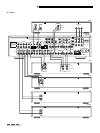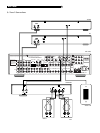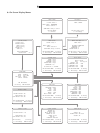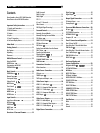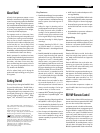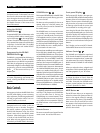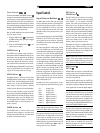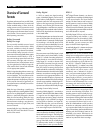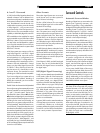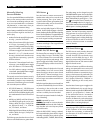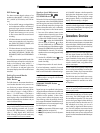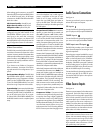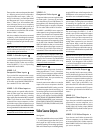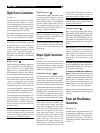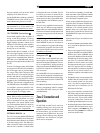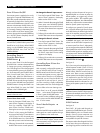
15
6.1 and 7.1 Surround
In 1999, the first Dolby Digital soundtrack was
released to theaters with an additional cen-
ter back surround channel, intended to increase
the directional effects from behind the audi-
ence. This additional surround channel is en-
coded into the two existing surround channels
in Dolby Digital 5.1, using a matrix encod-
ing process similar to that used previously in
Dolby Surround. This new extended surround
capability is called Dolby Digital Surround EX.
DTS has added a similar capability for record-
ing this extended surround information called
DTS-ES
®
6.1 Matrix. They have also taken it
one step further and developed the capabil-
ity to record this extended surround informa-
tion as a fully discrete channel in a system called
DTS-ES
®
6.1 Discrete.
All of these systems are extensions of the ex-
isting Dolby Digital 5.1 and DTS 5.1 digital
surround sound formats. Users with one cen-
ter back speaker (a 6.1 configuration) or two
center back speakers (a 7.1 configuration) can
take advantage of this extended surround in-
formation. Users with traditional 5.1 channel
systems can play Dolby Digital Surround EX
or DTS-ES 6.1 discs and they will sound ex-
actly the same as 5.1 channel discs in each
respective format. The extended surround
recordings are 100% backwards compatible.
If you have configured your system with one
or two center back speakers, decoding of
DTS-ES discs is automatic, just as it is with stan-
dard DTS soundtracks.
The RSP-1066 also features Rotel XS (eXtended
Surround) processing that automatically ensures
optimum extended surround performance on
6.1 and 7.1 channel systems. The key ben-
efit of Rotel XS is that it works at all times with
all multichannel digital signals, even those that
might not otherwise activate proper surround
decoding for the center back channel(s). Al-
ways active in any system configured with cen-
ter back speaker(s), Rotel XS monitors the sur-
round channels, properly decodes them, and
distributes the extended surround channels to
the center back speaker(s). Rotel XS works with
matrix-encoded surround signals (such as
Dolby Surround EX discs and non-flagged DTS-
ES) as well as non-matrix digital source mate-
rial (such as DTS 5.1, Dolby Digital 5.1, and
even Dolby Pro Logic II decoded Dolby Digi-
tal 2.0 recordings) to derive superb center back
channel surround effects.
Other Formats
Three other digital formats are not surround
sound formats at all, but rather systems for
digital 2-channel recordings.
The first is PCM 2-channel. This is a straight
2-channel digital signal such as that used for
standard CD recordings.
The second is HDCD
®
encoding for compact
discs. This system uses a variety of enhance-
ments to improve the sonic performance com-
pared to standard audio CDs. These discs,
labeled HDCD, can be played on standard
CD players. However, when the digital sig-
nal is decoded using an HDCD decoder like
that in the RSP-1066, they will provide excep-
tional musical reproduction.
The RSP-1066 also features a decoder for the
digital MP3 (MPEG1- Audio Layer 3) compres-
sion format. MP3 format recordings are avail-
able on the Internet and can be played on por-
table MP3 players or some disc players that
can read CD-ROM discs.
PCM 2-channel, HDCD, and MP3 are digital
formats. They can only be decoded by the
RSP-1066 from digital sources connected to
the digital inputs.
DSP (Digital Signal Processing)
Finally, one more related issue to be addressed
is DSP modes. Unlike all of the formats men-
tioned above, DSP is not a recording/play-
back system. Instead, it is a digital process-
ing feature of the RSP-1066 that adds special
acoustic effects to any signal. DSP process-
ing can be used with Dolby Surround record-
ings, Dolby Digital recordings, CDs, radio
broadcasts, or any other source material;
however, typically DSP settings would be used
with source material for which there is no
specific surround decoder.
In general, DSP is used to create the ambience
of a large listening environment: a jazz club,
a concert hall, a stadium, etc. It uses digital
processing to delay the signal to various speak-
ers and mix in various levels of reverberation.
Its use is strictly a matter of personal taste.
Surround Controls
Automatic Surround Modes
Decoding of digital sources connected to the
digital inputs is generally automatic, with
detection triggered by a “flag” embedded in
the digital recording telling the RSP-1066 what
decoding format is required. For example,
when Dolby Digital 5.1 or DTS 5.1 channel
surround is detected, the RSP-1066 activates
the proper decoding, confirmed by a lighted
indicator in the front-panel display.
The unit will also detect DTS-ES Matrix 6.1 or
DTS-ES Discrete 6.1 discs and activate DTS-ES
®
Extended Surround decoding. Likewise, a digi-
tal input from an HDCD
®
encoded compact
disc, a standard CD, or MP3 player will be
auto-detected and properly decoded to 2CH
stereo operation.
Rotel XS processing is automatically active in
all systems configured with center back
speaker(s) and will ensure proper extended
surround decoding of all multichannel digital
signals, even those that might not otherwise
trigger the proper extended surround mode.
In many cases, the RSP-1066 will also recog-
nize a digital signal with Dolby Surround en-
coding (such as the default soundtrack on many
DVDs) and activate Dolby
®
Pro Logic II
®
de-
coding. Additionally, you can configure a de-
fault surround mode for each input using the
ON-SCREEN DISPLAY menu system.
NOTE
: A digital signal coming into the
RSP-1066 will be recognized and properly
decoded. However, on a DVD with multiple
soundtracks, you must tell the DVD player
which one to send to the RSP-1066. For ex-
ample, you may need to use the DVD’s menu
system to select the Dolby Digital 5.1 or DTS
5.1 soundtrack rather than the default Dolby
Digital 2.0 Dolby Surround soundtrack. If in
doubt about what type of soundtrack is be-
ing sent from the DVD, check the front panel
indicator lights on the RSP-1066 to see which
type of decoding is activated: Dolby Pro Logic
(for Dolby Surround matrix soundtracks),
Dolby Digital, or DTS.
English



